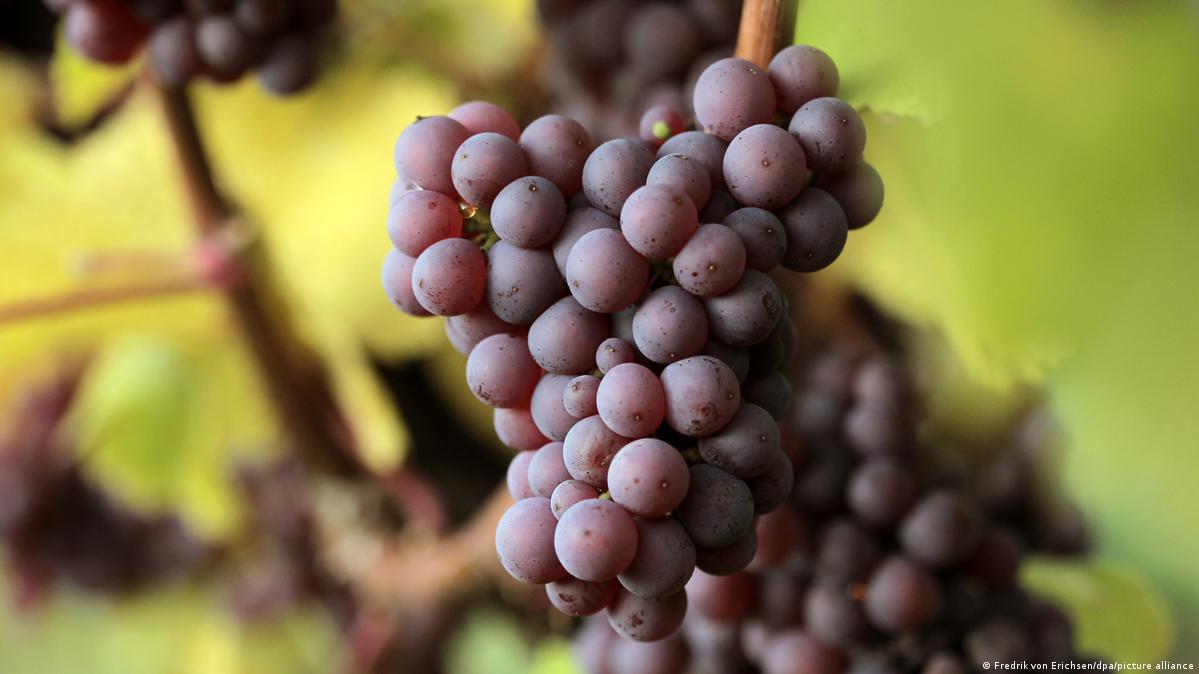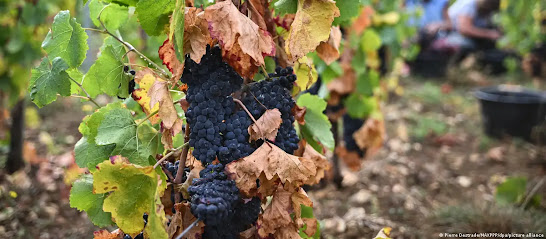Global wine production has been hit hard by a year of extreme weather in which floods, drought and frost severely stunted production. The only country that saw a significant increase in production was the US.
While EU production was extremely low, France was nevertheless able to regain its spot as the world's top wine producer
Image: Pierre Destrade/MAXPPP/dpa/picture alliance
Global wine production has fallen 7% on the year, resulting in the most meagre harvest since 1961, according to the International Organization of Vine and Wine (OIV) — a Dijon, France-based intergovernmental body that tracks wine production and consumption around the globe.
"Once again, extreme climatic conditions — such as early frost, heavy rainfall, and drought — have significantly impacted the output of the world vineyard," the OIV announced Tuesday.
"This negative scenario can be attributed to significant declines in major wine-producing countries in both Hemispheres," according to an OIV statement.
"While in the Southern Hemisphere, Australia, Argentina, Chile, South Africa, and Brazil recorded year-over-year variations between -10% and -30%; in the Northern Hemisphere, Italy, Spain and Greece are the countries that suffered the most from bad climatic conditions during the growing season."
So far, the OIV has refused to link those extreme conditions to climate change.
Germany's wine regions
Wine grape harvest is in full swing in Germany. Take a trip into the world of Riesling, Müller Thurgau, Silvaner and co.Image: Daniel Karmann/dpa/picture alliance
Global wine production has fallen 7% on the year, resulting in the most meagre harvest since 1961, according to the International Organization of Vine and Wine (OIV) — a Dijon, France-based intergovernmental body that tracks wine production and consumption around the globe.
"Once again, extreme climatic conditions — such as early frost, heavy rainfall, and drought — have significantly impacted the output of the world vineyard," the OIV announced Tuesday.
"This negative scenario can be attributed to significant declines in major wine-producing countries in both Hemispheres," according to an OIV statement.
"While in the Southern Hemisphere, Australia, Argentina, Chile, South Africa, and Brazil recorded year-over-year variations between -10% and -30%; in the Northern Hemisphere, Italy, Spain and Greece are the countries that suffered the most from bad climatic conditions during the growing season."
So far, the OIV has refused to link those extreme conditions to climate change.
Germany's wine regions
Wine grape harvest is in full swing in Germany. Take a trip into the world of Riesling, Müller Thurgau, Silvaner and co.Image: Daniel Karmann/dpa/picture alliance

Autumn is grape harvest time
German wine differs from wines of other countries - it's light, lively and fruity, thanks to Germany's unique climatic and geological conditions. The diversity of German wine stems from the many soil types and grape varieties. This diversity is reflected in Germany's 13 wine-growing regions.Image: Fredrik von Erichsen/dpa/picture alliance

Rheinhessen
The vineyards here are between Worms, Mainz and Bingen and cover an area of 26,000 hectares. This is Germany’s largest wine-growing region, in part dating back to the 9th century.Image: Fredrik Von Erichsen/dpa/picture alliance
14 images
Lowest production numbers since 1961
The OIV estimates that some 244.1 million hectoliters (mil) of wine will be produced in 2023, the lowest global output since 1961 — in which only 214 mhl were produced.
A hectoliter is the equivalent of 133 standard wine bottles.
In terms of global rankings, France, which was able to maintain previous production levels, was the world's top wine producer for the first time in nine years.
Italy ranked second as production slumped 12%, to its lowest levels since 2017.
Spain remained the world's number three producer despite output falling 14% year on year, and 19% over five years. With both Italy and Spain lagging, the EU saw its third-lowest output since the begging of the century, dropping 7% to 150 mhl. In Germany experts anticipated a slight increase in 2023.
Also bucking the trend, the world's fourth-largest wine producer, the US, saw a 12% increase in production in 2022 thanks to cooler temperatures and heavy winter rains in California's Napa and Sonoma valleys.
The only bright spot the OIV could identify in its data was the potential of reduced production to stabilize a shrinking market. "In a context where global consumption is declining and stocks are high in many regions of the world, the expected low production could bring equilibrium to the world market," said the OIV.
The OIV estimates that some 244.1 million hectoliters (mil) of wine will be produced in 2023, the lowest global output since 1961 — in which only 214 mhl were produced.
A hectoliter is the equivalent of 133 standard wine bottles.
In terms of global rankings, France, which was able to maintain previous production levels, was the world's top wine producer for the first time in nine years.
Italy ranked second as production slumped 12%, to its lowest levels since 2017.
Spain remained the world's number three producer despite output falling 14% year on year, and 19% over five years. With both Italy and Spain lagging, the EU saw its third-lowest output since the begging of the century, dropping 7% to 150 mhl. In Germany experts anticipated a slight increase in 2023.
Also bucking the trend, the world's fourth-largest wine producer, the US, saw a 12% increase in production in 2022 thanks to cooler temperatures and heavy winter rains in California's Napa and Sonoma valleys.
The only bright spot the OIV could identify in its data was the potential of reduced production to stabilize a shrinking market. "In a context where global consumption is declining and stocks are high in many regions of the world, the expected low production could bring equilibrium to the world market," said the OIV.
js/lo (AFP, dpa, Reuters)


No comments:
Post a Comment